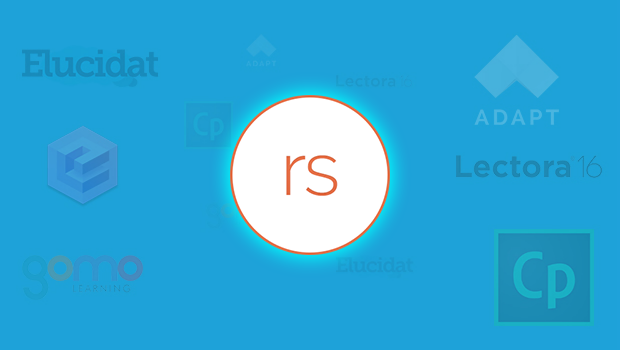We recently published a series of posts that discussed six responsive authoring tools ( Adapt, Evolve, gomo, Elucidat, Captivate 9, and Lectora 16 ) and concluded with seventh post that presented a feature-wise comparison of these tools.
Just about then, Articulate released its latest version, Articulate 360, which includes several tools and resources. We shared our initial reactions here; and mentioned that we were exploring Rise, the new responsive authoring tool included in the Articulate 360 suite. Now let’s take a closer look at the features, advantages, and limitations of Rise.
Articulate 360 – Rise
Rise is an online authoring tool that supports an up/down navigation approach between screens, with scrolling of individual screen content where required. It includes pre-built lesson (i.e. page) templates optimized for different devices types and orientations, and also allows you to use learning blocks to create custom lessons.
Because Rise is a part of the Articulate 360 suite, it also comes with several other tools that allow you to include specific types of content into Rise courses.
Features:
Views: Rise has 5 fixed default breakpoints, allowing you to design for desktop, tablet landscape and portrait, and smartphone landscape and portrait views.
Themes: Rise comes with one prebuilt theme. You can customize this theme for any particular course to suit your organization’s branding requirements by adding a logo, choosing a different or a custom color for the pre-set design elements, and selecting the fonts for headings and body text.
Lesson Templates: Rise includes a set of pre-built lesson templates for interactive content presentation like timeline, process, and labelled graphic; videos; activities; and quizzes. You can also use lesson templates to embed external content like YouTube or Vimeo videos, demo simulations created in Storyline or other tools and published as videos, or even animations created in other tools and published as videos. There is also an option to link to external content, in which case you can link to almost any type of content which is externally hosted.
Learning Blocks: Rise also gives you the option to use learning blocks to create custom lessons. Learning blocks can be stacked below one another to create specific layouts. You can choose from the Block Library to include a variety of text blocks, static graphic/image blocks, gallery blocks, multimedia blocks, and different types of interactivity blocks like accordion, tabs, flash cards, and knowledge check questions.
Content: Based on the lesson or block you’ve selected, Rise creates the appropriate layout and includes placeholders for all the required elements. You can then go ahead and add relevant content and media in the placeholders.
Actions: When working in Rise, you don’t need to apply or code any triggers or actions. All functionality is included within the available lesson and block types, and already optimized for the five different views. At lesson level, you can use Buttons/Buttons stacks to add links to lessons within the same course, resources hosted on the organization’s intranet, or external web links.
Media: Rise supports .mp4 video files and .mp3 audio files to target a wider range of devices.
Navigation: Rise allows you to set either free or restricted navigation between lessons and sections. With free navigation, you can also use Buttons/Button stacks to implement branching.
Menu: On larger devices, Rise gives you the option to display the open menu on the left or make it accessible through a menu icon in the top bar. On smaller devices, the menu automatically collapses and is accessible through an icon at the top left of the screen. On opening, the menu shows the list of sections with the lesson titles and status.
Course Management: Rise shows you your course structure visually on a single screen. You can re-sequence lessons and also edit specific lessons from this screen. The visual course structure can also help you to estimate your course development progress.
Quizzes: Rise allows you to create separate quizzes with multiple questions. Questions and options can be randomized. The entire quiz is contained on one screen, with internal navigation between questions. Available question types as of now include text-based single-select questions (MCQs).
Standards Compliance: Rise currently creates SCORM 1.2-, SCORM 2004-, and AICC-compliant output that can be distributed through LMSs. You also have the option to publish a standalone version.
Development Preview: You can choose to review one lesson or the entire course. When in the PREVIEW mode, you can use the 5 device icons to choose which view to display so you get an idea of how your content will look and behave on different devices.
Output Preview: Rise allows you to share a password-protected link to a course to anyone inside or outside your organization. This allows other stakeholders to review the course prior to release.
Supporting Tools from the Articulate 360 Suite:
Peek: You can capture demo simulations in Peek and import them into Rise as videos.
Replay 360: You can create screen cast lessons in Replay 360 and import them into Rise as videos.
Preso: You can create training videos in Preso and import them into Rise.
Observations/Limitations:
- Rise is most suitable for short, text-based courses. You can include audio clips and videos; however you cannot use the tool itself to sync the appearance of screen content with audio.
- Rise does not allow adding background images/videos to lessons.
- Quiz question formats are currently limited to single-select textual questions (MCQs).
- There is no live preview available. Every time you add or change the content, you have to regenerate a preview of a single screen or the entire course.
- Rise supports limited fonts; you cannot add any custom fonts or font styles. Also, any font you choose for a title or body text it is applied at global level – you cannot customize screen-level text to have different font types.
- Rise doesn’t allow you to import, modify, or create new templates; you can only use the lesson templates and block types provided.
- Rise restricts you to use its own navigation features. Additional global controls and features like play/pause or transcript buttons cannot be included in the player navigation.
- Currently, Rise does not include any gamification features.
- There is currently no support for any specific accessibility standards.
- There is currently no support for creating courses in different languages.
- There is currently no way for reviewers to add comments or annotations. Also, the preview link for a course always remains the same, so reviewers will see the latest version of the course. This can restrict you from updating your course until you’re sure all reviewers have completed their review.
- Rise courses cannot be imported or exported. This means you cannot share source files with your clients or vendors unless you grant them access to your account (or vice versa).
Offline Access:
The current version of Rise does not allow courses to be viewed and tracked when offline.
However, if you don’t need to track any data, you do have the option to download a course onto a desktop computer and view it without being connected. You can also download a course onto a mobile offline player or embed it into a native application.
Platform Support:
Rise supports the following platforms and browsers:
Windows
- Google Chrome (latest version)
- Microsoft Edge (latest version)
- Internet Explorer 11
- Firefox (latest version)
Mac
- Google Chrome (latest version)
- Safari (latest version)
- Firefox (latest version)
Mobile
- Safari in Apple iOS 8 or later
- Google Chrome in Apple iOS 8 or later
- Google Chrome in Android OS 4.1 or later
Conclusion:
Rise is best suited for shorter, text-based courses with simple content presentation methods. The default theme and design result in very clean, crisp looking courses. It is user-friendly for non-technical people, and its pre-built lessons and learning blocks allow for quick and easy content creation.
Rise may not be the most suitable tool if your content is primarily audio driven, simulation based, or very rich in animation.
Since Rise is part of the Articulate 360 suite, you can take advantage of other tools from the suite to create and import certain content into Rise.














